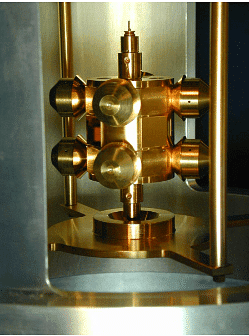What is Equivalence Principle? | Physics for EmSAT Achieve PDF Download
| Table of contents |

|
| The Newtonian Interpretation |

|
| The Einsteinian Interpretation |

|
| The Strong and Weak Equivalence Principles |

|
| Equivalence Principle Violations |

|
The Newtonian Interpretation
Gravitational mass refers to the charge that interacts with gravity, while inertial mass quantifies an object's responsiveness to acceleration. According to the equivalence principle, these two types of mass are equivalent. This means that the gravitational force experienced by an object is directly proportional to its inertial mass, regardless of the type of matter involved. Consequently, all objects fall with the same acceleration in a uniform gravitational field, such as the acceleration of 9.8m/s² near the Earth's surface.
The Einsteinian Interpretation
- Under the influence of gravity, all objects fall in the same manner, making it impossible to distinguish between an accelerated frame and an unaccelerated frame in local observations. Consider the example of a person in a falling elevator, where the person floats weightlessly in the elevator as it descends. Locally, over small time intervals or distances, the person cannot perceive any distinction between being in the falling elevator and being in empty space devoid of gravity.
- To illustrate this, imagine two apples suspended on either side of the person. As the elevator approaches the Earth, the apples will draw closer to each other because both paths converge toward the Earth's center. However, this convergence cannot be detected through local experiments.
- This statement of the equivalence principle suggests something significant. In special relativity and classical mechanics, objects move at a constant velocity unless acted upon by a force. If it is indistinguishable locally between falling in a gravitational field and traveling at constant velocity, then they must be equivalent phenomena. Deviations from constant velocity indicate a curvature in spacetime itself, as the paths of freely moving objects define what is considered "straight."
- Formally, the equivalence principle can be expressed as follows: In any locally Lorentz (inertial) frame, the laws of special relativity must hold true. From this, we deduce that the geometric structure of spacetime is solely determined by the trajectories of freely moving objects.
The Strong and Weak Equivalence Principles
There are often references to the "strong" and "weak" equivalence principles. The weak equivalence principle encompasses the equality of gravitational and inertial mass, as well as the assertion that special relativistic laws apply in every locally Lorentz frame, particularly regarding the "laws of freely falling bodies." The strong equivalence principle extends to all laws of nature and implies that even gravitational self-energy must adhere to the equivalence principle.
Which measurements have we conducted?
We have performed tests on the Equivalence Principle, specifically the Universality of Free Fall (UFF), in the following scenarios:
Test bodies made of Be, Al, Cu, and Si attracted by the Earth. These experiments yielded null results and represent the most accurate laboratory tests of the UFF. Our findings indicate that the proposed "fifth force" and its natural extensions do not exist.
Test bodies made of Be, Al, Cu, and Si attracted by the Sun. The objective here was to complement lunar laser-ranging data, which effectively test the UFF for the Earth and Moon falling toward the Sun. The laser-ranging data assess whether gravitational self-energy adheres to the Equivalence Principle, as the Earth's mass includes a contribution from gravitational binding energy that is larger (4 × 10-10) compared to the Moon's contribution (2 × 10-11). However, the laser-ranging test examines a combination of two effects: the differing gravitational self-energies and the differing compositions (the Earth possesses an Fe-Ni core while the Moon does not) of the Earth and Moon. In our experiment, we compare the accelerations of special test bodies toward the Sun, which closely resemble the compositions of the Earth's core and the Moon's surface. We anticipate achieving sufficient precision to leverage the accuracy of the laser-ranging data.
Test bodies made of Be, Al, Cu, and Si attracted toward the center of our Galaxy. The objective here was to investigate, within a laboratory setting, whether the significant force between dark matter and ordinary matter is solely gravitational (i.e., adheres to the UFF). Our work demonstrated that this was indeed the case for Galactic dark matter. We are currently developing the Eöt-Wash III instrument to extend our testing to cosmological dark matter, as the relevant accelerations are smaller and require greater experimental sensitivity.
Test bodies made of Cu and Pb attracted toward a compact 3-ton 238U attractor. The purpose here was to examine the UFF at short ranges, employing an attractor with a distinct N/Z (neutron-to-proton) ratio compared to the Earth. This experiment aimed to address the "gap" between 10 km and 1000 km, where Eötvös-type experiments with the Earth as an attractor exhibit limited sensitivity. Uranium was selected for its high density, allowing us to position a substantial mass in proximity to the torsion balance. This instrument provided valuable constraints for distances down to 1 cm, corresponding to exchange-boson masses up to 2 × 10-5. These findings encompass the "Turner window," where astrophysical constraints are relatively weak.

Equivalence Principle Violations
- The equivalence principle (EP) asserts that all local laws of special relativity hold universally, regardless of the type of matter involved. For a significant period, there was no reason to question this principle. However, in modern quantum theories, it is often postulated that the EP could be violated at certain scales, typically within a few centimeters.
- What types of forces could potentially violate the equivalence principle? One familiar form of EP violation arises from any vector field that interacts with mass. To illustrate this, consider electromagnetism, which is a vector field. With two electrical charges, a positive charge behaves differently from a negative charge in an electric field. The existence of charges and anticharges is a general characteristic of vector fields. If a vector field were to couple with mass, it would necessitate the presence of both mass and antimass, which would behave oppositely in the same gravitational field, thereby violating the EP.
- EP violations can also arise from scalar fields. Scalar charges, unlike vector charges, are not conserved. The conservation of a vector charge is a Lorentz invariant statement. The charge of an object is determined by integrating the time component of its vector current density, which undergoes a factor adjustment under Lorentz transformations, over a volume element that undergoes a reciprocal factor adjustment. Consequently, the integral as a whole remains Lorentz invariant. In the case of a scalar charge, the relevant integral involves a charge density (a Lorentz scalar) integrated over a volume, where only the volume element experiences a factor adjustment under a Lorentz transformation. As a result, scalar charges are not conserved and are dependent on the reference frame.
- This factor can lead to peculiar phenomena. Quarks within protons and neutrons possess high relativistic speeds, while electrons orbiting the nucleus move at a slower pace (v/c ~ Z, where Z represents the atomic number). Therefore, we anticipate that scalar interactions would vary with the composition, as electrons in larger atoms are farther from the nucleus and exhibit slower motion.
|
215 videos|402 docs|221 tests
|














